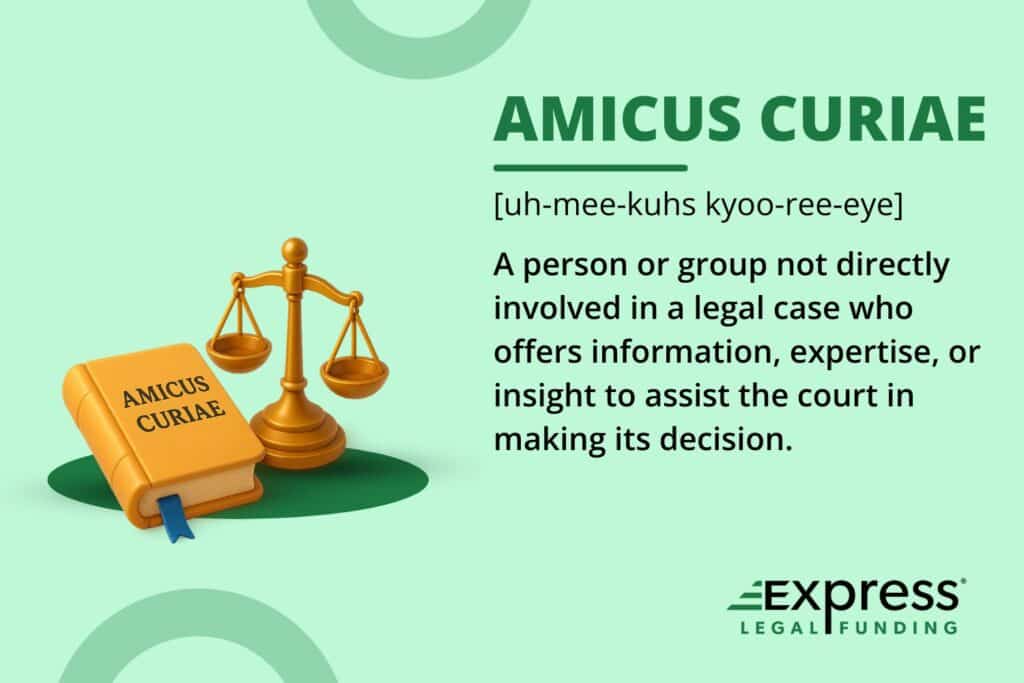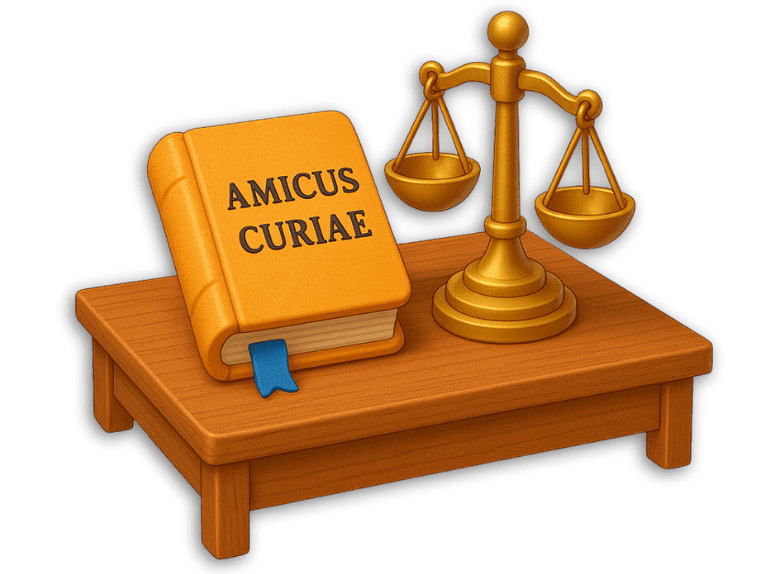The term “Amicus Curiae,” Latin for “friend of the court,” refers to a person or organization that is not a party to a legal case but is permitted to assist a court by offering information, expertise, or insight that has a bearing on the issues in the case.
This guide aims to provide a comprehensive understanding of the role and significance of amicus curiae in the legal system, particularly within the United States.
By exploring applicable laws, procedural rules, and jurisdictional variations, this guide will serve as a valuable resource for both legal professionals and laypersons interested in the intricacies of this legal concept.
What Does Amicus Curiae Mean?
“Amicus Curiae,” a Latin term meaning “friend of the court,” refers to individuals or organizations that provide information, expertise, or insights to a court, despite not being directly involved in the case. The primary purpose of an amicus curiae is to assist the court in making a more informed decision by presenting perspectives or data that the parties involved may not fully cover.
The term “amicus curiae” is pronounced as “uh-MEE-kus KYOO-ree-eye” in American English and may have slightly different regional variations.
The concept of amicus curiae has its roots in Roman law, where individuals could offer their expertise to assist judges. This practice was later adopted in English common law, where it became a formalized mechanism for providing courts with additional insights.
In English law, the role of amicus curiae was primarily advisory, allowing courts to benefit from external knowledge.

What Is an Amicus Curiae Brief?
An amicus curiae brief is a formal document submitted to a court by an amicus curiae, or “friend of the court.” This brief provides additional information, expertise, or perspectives that may assist the court in making a more informed decision.
Unlike the parties directly involved in the litigation, who focus on their specific interests, an amicus curiae brief aims to present broader implications, specialized knowledge, or alternative legal arguments that the court might not otherwise consider.
These briefs are particularly common in appellate courts, including the U.S. Supreme Court, where they can play a crucial role in shaping the interpretation of complex legal issues.
Development of Amicus Curiae Briefs in the U.S. Legal System
In the United States, the use of amicus curiae briefs has evolved significantly, particularly within the U.S. Supreme Court. The practice gained prominence in the 20th century as courts recognized the value of external perspectives in complex cases.
Today, amicus curiae briefs are a common feature in appellate litigation, with various organizations, including government agencies, non-profits, and industry groups, frequently participating as amici.
Examples of Amicus Curiae Briefs in Landmark Cases
One of the most notable examples of an amicus curiae brief influencing a court’s decision is the landmark case of Brown v. Board of Education (1954). In that case, several amicus briefs, including one from the U.S. government, argued against racial segregation in public schools.
The information and social science research presented in these briefs helped the Supreme Court conclude that segregation was unconstitutional.
Other significant examples include:
- District of Columbia v. Heller (2008): Amicus briefs from historians, constitutional scholars, and advocacy groups presented competing views on the history and meaning of the Second Amendment. These submissions gave the Court extensive historical context in reaching its decision that the Second Amendment protects an individual’s right to bear arms.
- Obergefell v. Hodges (2015): Numerous amici, including civil rights organizations, medical associations, and major corporations, filed briefs supporting same-sex marriage rights. Their arguments highlighted the broader social, health, and economic consequences of denying marriage equality. The Court’s majority opinion reflected many of these perspectives.
The insights provided by these briefs played a crucial role in the Supreme Court’s decision to declare segregation unconstitutional, demonstrating the significant impact of amicus curiae participation in shaping legal outcomes.
How Is Amicus Curiae Different from Parties to the Case?
The key difference between an amicus curiae and a party to the case lies in their roles and interests. Parties to the case are directly involved in the litigation, presenting evidence and arguments to support their position, and are subject to the court’s ruling.
In contrast, an amicus curiae does not have a direct stake in the outcome but seeks to enhance the court’s understanding through its brief. While the court’s decision directly affects the parties, the amicus curiae’s involvement is limited to providing supplementary insights.
What Are the Functions of Amicus Curiae?

Amicus curiae plays a vital role in the judicial process by providing courts with additional perspectives and information that may not be fully represented by the parties involved in a case. Here are the primary functions of amicus curiae:
1. Providing Expertise and Specialized Knowledge
Amicus curiae can offer specialized knowledge or expertise on complex issues that are beyond the typical scope of the court’s understanding. This is particularly valuable in cases involving technical, scientific, or industry-specific matters where expert insights can aid the court in making informed decisions.
2. Highlighting Broader Implications
By submitting briefs, amici can draw attention to the broader implications of a court’s decision. This includes potential impacts on public policy, societal norms, or future legal interpretations. Such insights help the court consider the wider consequences of its ruling beyond the immediate parties involved.
3. Supporting Public Interest
Amicus curiae often represent public interest groups or non-profit organizations that advocate for specific causes or communities. Their participation ensures that the interests of these groups are considered, even if they are not directly involved in the litigation. This function is crucial in cases with significant social or ethical dimensions.
4. Assisting in Legal Interpretation
Amici can assist the court in interpreting complex legal doctrines or statutory provisions. By providing historical context, legislative intent, or comparative legal analysis, amicus briefs can help clarify ambiguous legal issues and guide the court in its interpretation.
5. Offering Alternative Legal Arguments
Amicus curiae can present alternative legal arguments or perspectives that the parties to the case may not have considered. This can enrich the court’s deliberations by introducing new angles or considerations that might otherwise be overlooked.
6. Influencing Judicial Outcomes
While amici curiae do not have a direct stake in the case’s outcome, their contributions can influence judicial decisions. By providing well-reasoned arguments and credible evidence, amici can sway the court’s opinion or reinforce the arguments of one of the parties.
Who Can and Who Cannot File Amicus Curiae Briefs?
Who Can File Amicus Curiae Briefs?
Amicus curiae briefs can be filed by a wide range of individuals and organizations, including:
- Non-Profit Organizations: Advocacy groups and public interest organizations often file amicus briefs to represent the interests of specific communities or causes.
- Government Agencies: Federal, state, and local government entities may submit briefs to provide insights on how a court’s decision could impact public policy or government operations.
- Industry Associations: Trade groups and professional associations may file briefs to highlight the potential effects of a court’s decision on a particular industry or sector.
- Academic Institutions and Scholars: Universities, research institutions, and legal scholars can offer expert analysis or historical context on complex legal issues.
- Corporations and Businesses: Companies may file amicus briefs to address how legal decisions could affect their operations or the broader business environment.
- Individuals: In some cases, individuals with relevant expertise or a vested interest in the case’s outcome may be permitted to file amicus briefs.
Who Cannot File Amicus Curiae Briefs?
While courts welcome a wide range of amicus participation, there are important restrictions:
- Parties to the Case: The litigants themselves cannot file amicus briefs since they are already presenting their arguments directly to the court.
- Entities Without Court Permission: In many appellate courts, including the U.S. Supreme Court, amici must either obtain the consent of all parties or file a motion for leave requesting permission from the court. If consent or leave is denied, the amicus curiae brief cannot be filed
- Amici with Conflicts of Interest: Courts generally will not bar a brief solely because of a conflict, but they may give it little or no weight if it appears biased or overly aligned with one side. This helps ensure that amicus participation remains genuinely useful and not just an extension of advocacy by a party.
What Are the Exceptions and Restrictions to Filing Amicus Curiae Briefs?
While amicus curiae briefs are an important tool for providing courts with outside perspectives, their filing is not unlimited. Courts impose rules to ensure these submissions are relevant, fair, and helpful to the judicial process. Key exceptions and restrictions include:
- Court Permission Requirements: In many jurisdictions, including the U.S. Supreme Court, amici must obtain either the consent of all parties or leave of the court before filing. Without permission, the brief cannot be submitted.
- Strict Filing Deadlines: Amicus briefs must follow the court’s schedule. Late filings are often rejected to prevent disruption of proceedings.
- Conflicts of Interest: Briefs filed by entities with direct or obvious bias may be given little weight, ensuring the role of amici remains informative rather than purely advocacy-driven.
- Relevance and Non-Redundancy: Courts may decline briefs that merely repeat party arguments or fail to provide new, valuable information.
- Length and Format Rules: Most courts enforce word limits, page restrictions, and formatting requirements to keep briefs concise and clear.
- Restrictions on Certain Filers: Parties to the case cannot file amicus briefs, and individuals or groups without demonstrated expertise or interest may be denied.
These limitations help maintain the integrity of judicial proceedings by ensuring amicus briefs enhance, rather than hinder, the court’s deliberations.
When Do Courts Allow Amici to Participate?
Courts allow amici curiae to participate when their perspectives add value beyond those of the litigants. This often includes cases with complex legal or technical issues, significant public interest, broader legal implications, or government involvement. Amicus briefs in these contexts help judges consider wider consequences and make more informed decisions.
Key Situations Allowing Amicus Curiae Participation
- Complex Legal Issues: Experts and organizations clarify technical or specialized matters.
- Significant Public Interest: Ensures diverse perspectives in cases affecting constitutional rights or social policy.
- Broader Legal Implications: Provides context when rulings may set precedent or shape future legal interpretations.
- Government or Institutional Interest: Agencies and institutions highlight impacts on governance and policy.
How to Write an Amicus Curiae Brief?
Writing an amicus curiae brief involves a structured approach to ensure that the document effectively communicates valuable insights and information to the court. Here is a step-by-step guide to crafting a compelling amicus curiae brief:
1. Understand the Case and Its Context
Before drafting the brief, thoroughly understand the case’s background, legal issues, and potential implications. Review the parties’ briefs, relevant case law, and any previous decisions that may influence the court’s ruling. This understanding will help you identify the unique perspective or expertise your brief can offer.
2. Determine the Brief’s Purpose and Focus
Identify the specific purpose of your amicus brief. Are you providing specialized knowledge, highlighting broader implications, or offering alternative legal arguments? Clearly define the focus of your brief to ensure it adds value to the court’s deliberations.
3. Seek Permission or Consent
In many jurisdictions, you must seek the court’s permission or obtain consent from the parties involved to file an amicus brief. This may involve submitting a motion for leave to file, explaining the relevance and importance of your contribution.
4. Follow Court Rules and Guidelines
Adhere to the specific rules and guidelines set by the court for amicus briefs. This includes formatting requirements, word count limits, page limits, and filing deadlines. Ensure your brief complies with these rules to avoid rejection.
5. Structure the Brief Effectively
A well-structured amicus brief typically includes the following sections:
- Cover Page: Include the case name, docket number, court name, and title of the brief.
- Table of Contents: Provide a clear outline of the brief’s sections and page numbers.
- Table of Authorities: List all legal authorities cited in the brief, such as cases, statutes, and regulations.
- Statement of Interest: Explain your interest in the case and why your perspective is valuable to the court.
- Summary of Argument: Provide a concise overview of the main points and arguments presented in the brief.
- Argument: Present your detailed arguments, supported by legal authorities, data, or expert analysis. Focus on providing new insights or perspectives that the parties may not have fully addressed.
- Conclusion: Summarize your key points and suggest the outcome you believe the court should reach.
6. Use Clear and Persuasive Language
Write in a clear, concise, and persuasive manner. Avoid legal jargon and ensure your arguments are accessible to the court. Use logical reasoning and evidence to support your points, and anticipate potential counterarguments.
7. Review and Revise
Carefully review and revise your brief to ensure accuracy, clarity, and coherence. Check for compliance with court rules and correct any grammatical or typographical errors. Consider seeking feedback from colleagues or legal experts to strengthen your arguments.
8. File the Brief
Submit the brief to the court according to the specified procedures and deadlines. Ensure that copies are distributed to all parties involved in the case.
The Process: How Do Amicus Curiae Briefs Work?
Amicus curiae briefs follow a structured process that allows outside individuals or organizations to provide courts with insights beyond the parties’ arguments. The process typically involves:
- Identifying the Need: Amici step in when a case raises complex legal questions or broader societal implications. Advocacy groups, professional associations, or government entities may offer expertise to help the court reach a more informed decision.
- Seeking Permission: In many jurisdictions, amici must obtain court approval or party consent before filing. This requires a motion explaining the relevance of their input. Courts grant permission only when the brief is likely to add value.
- Preparing the Brief: The amicus curiae drafts a focused legal document that presents arguments, data, or perspectives not fully addressed by the litigants. Successful briefs are concise, well-researched, and highlight unique insights.
- Filing with the Court: Briefs must comply with strict procedural rules and deadlines, ensuring both the court and the parties can review them before hearings or deliberations.
- Judicial Review: The court reviews amicus briefs alongside party submissions. While not required to consider them, judges often use these insights to better understand complex issues or policy implications.
- Influence on the Decision: Strong amicus briefs can shape judicial reasoning, frame broader legal implications, and even influence precedent-setting rulings.
- Post-Decision Impact: After rulings, legal scholars and media often analyze the role of amici to evaluate their influence on the outcome and its effect on future cases.
Filing Procedure in the U.S. Supreme Court and Other Courts
The filing procedure for amicus curiae briefs varies between courts, but there are general guidelines that amici must follow, particularly in the U.S. Supreme Court:
U.S. Supreme Court
- Seeking Consent or Leave: Amici must either obtain the consent of all parties involved in the case or file a motion for leave to submit an amicus brief. The motion should explain the relevance and importance of the brief.
- Permitted Filers: In the U.S. Supreme Court, an amicus curiae brief must be filed by an attorney who is admitted to practice before the Court. Non-lawyers, organizations, or outside groups cannot file directly; instead, they must work through counsel of record admitted to the Supreme Court bar.
- Filing Deadlines: The U.S. Supreme Court sets strict timelines for amicus curiae briefs under Rule 37:
- At the petition stage: Amicus briefs must be filed within 30 days after the case is placed on the Court’s docket.
- At the merits stage (supporting a petitioner or appellant): Briefs are due within 7 days after that party files its main brief.
- At the merits stage (supporting a respondent): Briefs are due within 7 days after the respondent files their main brief.
- Content and Format: The brief must comply with the Supreme Court’s rules regarding content, length, and format. This includes a cover page, table of contents, table of authorities, and a statement of interest explaining the amicus’s stake in the case.
- Distribution: Copies of the brief must be distributed to all parties involved in the case, as well as to the court.
Other Courts
- Permission Requirements: Similar to the Supreme Court, other courts may require amici to seek permission to file a brief. This often involves submitting a motion or application to the court.
- Adherence to Local Rules: Each court may have its own rules and procedures for filing amicus briefs, including specific deadlines and formatting requirements. Amici must adhere to these local rules to ensure their briefs are accepted.
- Focus on Relevance: Courts generally expect amicus briefs to provide new or relevant information that aids in the court’s understanding of the case. Redundant or irrelevant briefs may be rejected.
What Is the Role of the U.S. Solicitor General in Amicus Curiae Briefs?
The U.S. Solicitor General is often regarded as the Supreme Court’s most influential amicus curiae. As the federal government’s top courtroom advocate, the Solicitor General frequently submits amicus briefs in cases where the United States is not a party but has a strong national interest in the outcome. These briefs carry extraordinary weight because the Court views the Solicitor General as a highly credible source of legal expertise and balanced policy analysis.
The Solicitor General’s role extends beyond filing briefs. The office regularly advises the Court on whether to grant certiorari (hear a case) and helps shape the reasoning behind landmark decisions. Because of this unique influence, the Solicitor General is sometimes called the Court’s “Tenth Justice.”
Key responsibilities include:
- Maintaining Credibility: The Court relies heavily on the Solicitor General’s candor. Credibility is built on consistently presenting fair, well-reasoned arguments, even when they may not fully align with an administration’s immediate political interests. This trust is why the office is sometimes referred to as the “Tenth Justice.”
- Representing the Federal Government: The Solicitor General oversees all litigation involving the U.S. before the Supreme Court. This includes arguing cases where the government is a party, determining which cases to appeal, and reviewing adverse decisions from lower courts to decide whether to seek further review
- Filing Amicus Curiae Briefs: Even when the government is not directly involved in a case, the Solicitor General often files amicus briefs to present the federal government’s perspective on critical legal questions. These briefs provide the Court with insights into how a ruling may affect national law, governance, or policy.
- Advising on Certiorari: One of the Solicitor General’s most important roles is recommending whether the Supreme Court should hear certain cases. The Court frequently asks for this input, and justices often give substantial weight to the Solicitor General’s judgment because of the office’s expertise.
- Balancing Law and Policy: The Solicitor General must ensure the government’s legal positions are firmly grounded in law while also aligning with broader policy goals. This balancing act requires deep legal knowledge as well as sensitivity to the political and social consequences of decisions.
- Shaping Legal Precedent: Through arguments and amicus briefs, the Solicitor General plays a pivotal role in shaping constitutional and statutory interpretation. The positions taken by the office often influence how legal doctrines evolve, impacting civil rights, federal authority, and economic regulation.
What Are the Benefits and Criticisms of Amicus Curiae?
The role of amicus curiae in the judicial process is both valuable and controversial. Supporters highlight how amici broaden perspectives and strengthen legal reasoning, while critics warn that they can introduce bias or overwhelm the courts.
Examining both the benefits and criticisms offers a balanced view of their true impact on the legal system.

Benefits of Amicus Curiae Briefs
- Broader Perspectives Beyond the Litigants
- Amicus curiae briefs provide courts with additional perspectives that extend beyond the interests of the litigants. This ensures that the court considers a wider array of viewpoints, which can lead to more comprehensive and balanced judicial decisions.
- Ensuring Technical Clarity
- Amici often possess specialized knowledge or expertise in specific areas, such as scientific, technical, or industry-specific matters. Their insights can help clarify complex issues, ensuring that the court fully understands the technical aspects of a case.
- Promoting Fairness and Democratic Input
- By allowing diverse groups to participate in the judicial process, amicus briefs promote fairness and democratic input. This ensures that the interests of various communities and stakeholders are represented, particularly in cases with significant social or ethical dimensions.
- Representation of Public Interest
- Amicus briefs can represent the interests of groups or communities that are not directly involved in the litigation. This ensures that diverse perspectives are considered, particularly in cases with significant social or ethical dimensions.
- Highlighting Broader Implications
- Amici can draw attention to the broader legal, social, or policy implications of a court’s decision. This helps the court consider the long-term effects and potential precedents set by its ruling.
- Influencing Legal Development
- Through their contributions, amici can influence the development of legal doctrines and the interpretation of laws. This can lead to more nuanced and comprehensive legal precedents.
Criticisms of Amicus Curiae
- Risk of Lobbying and Special Interest Influence
- Critics argue that some amicus briefs may be influenced by lobbying efforts or serve as advocacy tools for special interests. This can undermine the objectivity of the information presented and potentially sway the court’s decision in favor of particular agendas.
- Volume of Briefs Overwhelming the Courts
- The submission of numerous amicus briefs can overwhelm the court with information, making it challenging to discern which contributions are genuinely valuable. This can complicate the court’s deliberations and delay the decision-making process.
- Wealthier Groups Dominating the Narrative
- There is a concern that well-funded organizations or entities with significant resources may have a disproportionate influence on the court through amicus briefs. This can create an imbalance in the representation of interests and perspectives, allowing wealthier groups to dominate the narrative.
- Potential for Bias and Advocacy
- Some amicus briefs may be biased or serve as advocacy tools for specific interests. This can undermine the objectivity of the information presented and potentially sway the court’s decision in favor of particular agendas.
- Redundancy and Lack of Relevance
- Some amicus briefs may reiterate arguments already presented by the parties or lack substantive value. This redundancy can detract from the court’s focus on the most pertinent issues.
- Procedural Challenges
- The process of seeking permission to file and adhering to specific court rules can be cumbersome for potential amici. This may discourage valuable contributions from entities with limited resources or legal expertise.
Conclusion: Why You Should Care About Amicus Curiae
Despite these criticisms, the role of amicus curiae remains a crucial component of the judicial process. By providing broader perspectives, ensuring technical clarity, and promoting fairness, amicus curiae briefs contribute to a more democratic and informed legal system.
Understanding their significance allows individuals to appreciate the complexities of legal decision-making and the importance of diverse perspectives in shaping just and equitable outcomes.
Whether you are a legal professional or a layperson, recognizing the value of amicus curiae can enhance your understanding of how laws are interpreted and applied in courts across the United States.

